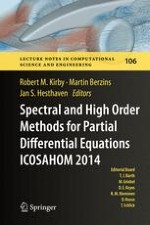2015 | Buch
Spectral and High Order Methods for Partial Differential Equations ICOSAHOM 2014
Selected papers from the ICOSAHOM conference, June 23-27, 2014, Salt Lake City, Utah, USA
herausgegeben von: Robert M. Kirby, Martin Berzins, Jan S. Hesthaven
Verlag: Springer International Publishing
Buchreihe : Lecture Notes in Computational Science and Engineering
